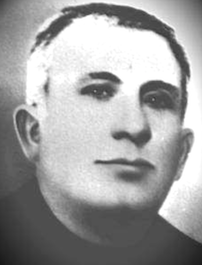Priests: Shed Your Blood Before You Break the Seal! Follow St. Mateo Correa
- MARY HANSEN
According to Canon Law and the Catechism of the Catholic Church the Seal of Confession is inviolable.
 Saint Mateo Correa
Saint Mateo Correa1866-1927
Recently, the head of France's Bishops' Conference, Archbishop de Moulins-Beaufort, said that the Seal of Confession should not take precedence over French law (dealing with sex crimes against children). This scandalous statement was the exact opposite of what he had said earlier. What made him change his mind? Well, could it be because he had been summoned for a meeting by the Interior Minister, Gerald Darminin? Could that have something to do with it? It was after this meeting that he reversed his initial position of non-compliance with the government mandate. Even more scandalous, he asked the public to forgive him for his prior statement! This, from the top bishop in France, the "eldest daughter of the Church."
According to Canon Law and the Catechism of the Catholic Church the Seal of Confession is inviolable. "A confessor who directly violates the Seal of Confession incurs an automatic excommunication."
This is light years away from another priest, from another time, from another country, who was faced with a similar challenge: Father Mateo Correa. A Mexican priest who literally gave up his life to protect the Seal of Confession. On Feb. 5, 1927, the country's revolutionary forces ordered the imprisoned priest to divulge the contents of several soldiers' confessions. "Never! I will never do it!" he said. "I would rather die than violate the Seal of Confession." "Then you will die!" shrieked his adversary, with a gun pointed at the priest's head. The next day, at dawn on Feb. 6, 1927, he was taken to the outskirts of Durango and executed. He was canonized by St. John Paul II in 2000.
The years 1926 to 1929 are known as the "Years of the Martyrs" in the history of the Mexican Republic. In the words of English writer Graham Greene (he was an atheist until he converted to the Catholic faith at age 22) the church in Mexico under its socialist dictators suffered "the fiercest persecution of religion anywhere since the reign of Elizabeth." Pope Pius XI, who presided over the Church from 1922 to 1939, declared that the persecutions in Mexico "exceeded the most bloody persecutions of the Roman emperors." His 1926 encyclical, Iniquis Afflictisque, refers to the barbarities as "without equal, cruelties and atrocities scarcely credible in the 20th century."
A priest was not allowed to say Mass, give absolution or even say a prayer over a dying Mexican soldier. Such acts were punishable by law. Father Mateo was arrested because he was bringing Viaticum to a dying invalid; Masses, however, were being said. In secret. In private homes. In forests. In garages. The Church in Mexico was forced to go "underground." Such a scene is vividly portrayed in Graham Greene's masterpiece novel, The Power and the Glory:
It had been five years since the people had seen a priest.
A voice whispered urgently to him, 'Father.'
'Yes?'
'The police are on the way. They are only a mile off, coming through the forest.'
This was what he was used to: were they on horseback or on foot? If they were on foot he had 20 minutes left to finish Mass and hide — the Consecration was in silence: no bell rang. Somebody opened the door: a voice whispered urgently, 'They're here — They are all around the village.'
Father Mateo Correa was born in Tepechitlan, Zacatecas, on July 23, 1866. Although he was from a poor family, he completed his education with the aid of benefactors and attended the seminary in Zacatecas on a scholarship. After his ordination in 1893 the gentle priest served as pastor in several locations in the state of Zacatecas. One of these was in the mining town of Concepcion del Oro where he became friends with the family of Miguel Pro whose father was a mining engineer. Miguel would eventually become the best-known of all the Mexican martyrs. Father Mateo administered First Communion to the young Miguel and baptized Miguel's brother Umberto. Both brothers would be martyred on the same day in 1927. As Robert Royal said in his book, The Catholic Martyrs of the Twentieth Century, such ironies are "indicative of the all-embracing nature of anti-Catholic persecution in Mexico."
The relics of Father Mateo can be found in the Cathedral of Durango, a city 600 miles northwest of Mexico City. The church is also known as the Minor Basilica of the Immaculate Conception. This "landmark of enduring beauty" is located in the historic centre of the city opposite the Plaza de Armas. Construction on the impressive church with its twin-towered Baroque façade was begun in 1695.
Durango is not only a destination for devout Catholics but for fans of John Wayne as well. Many of Hollywood's greatest western movies were filmed there. As one writer said, "This is John Wayne country, where the Duke slugged it out, shot it out, and sometimes yelled it out, as he tamed the American West." One of his most famous movies, True Grit, for which he won an Oscar in 1970, was filmed in Durango. Wayne spent a great deal of time in this city and eventually bought property in the area.
"The Duke" converted to the Catholic faith two days before he died of cancer in 1979. According to his grandson, Father Matthew Munoz, a priest in California, he regretted that he had taken so long to take this step. He blamed it on a "busy life." All of his seven children were brought up in the Catholic faith and attended Catholic schools. Apparently, he had a long-standing reverence for Catholicism. His director John Ford (who didn't hide his love for his Catholic faith) influenced him, as did his good friend in Los Angeles, Archbishop Tomas Clavel, who had been exiled from his Archdiocese of Panama in 1968.
And one can just wonder at the possible influence of Father Mateo Correa on this movie legend. Surely, Wayne, given his interest in Catholicism, would have visited this beautiful Cathedral many times. And how moved he must have been by reading the description in the church of Father Mateo's martyrdom.
Some of Wayne's most memorable quotes dealt with the subject of courage. One of his best-known was: "Courage is being scared to death — and saddling up anyway." How in awe he must have been by Father Mateo's bravery!
One can only barely surmise the terror in Father Mateo's heart on that night of Feb. 5, 1927. Alone in his prison cell he had no illusions about any such fictions as a last-minute reprieve. How easily he could have given in! Knowing what possible tortures and brutalities awaited him.
Yet he stayed the course. To the point of martyrdom.
Unlike another priest, an Archbishop at that, decades later, who did "give in." To the Interior Minister's admonitions. Or threats. Or whatever it was. To which one can only say, "God help the Church in France."
 This is Meaghen Gonzalez, Editor of CERC. I hope you appreciated this piece. We curate these articles especially for believers like you.
This is Meaghen Gonzalez, Editor of CERC. I hope you appreciated this piece. We curate these articles especially for believers like you.
Please show your appreciation by making a $3 donation. CERC is entirely reader supported.

Acknowledgement
 Mary Hansen. "Priests: Shed Your Blood Before You Break the Seal! Follow St. Mateo Correa." OnePeterFive (November 13, 2021).
Mary Hansen. "Priests: Shed Your Blood Before You Break the Seal! Follow St. Mateo Correa." OnePeterFive (November 13, 2021).
Reprinted with permission.
The Author
 Mary Hansen writes at MadonnasOfMexico.com. She is a former teacher with a B.A. from Queen’s University and a Master of Education and Master of Divinity from the University of Toronto (St. Michael’s). She writes from Ontario.
Mary Hansen writes at MadonnasOfMexico.com. She is a former teacher with a B.A. from Queen’s University and a Master of Education and Master of Divinity from the University of Toronto (St. Michael’s). She writes from Ontario.




